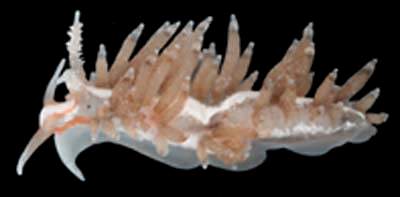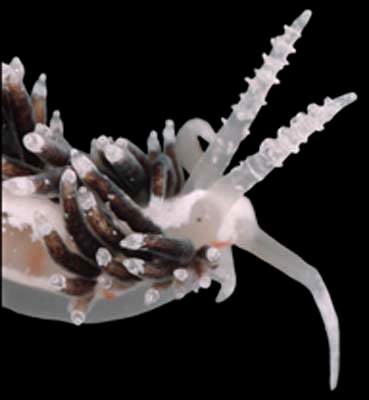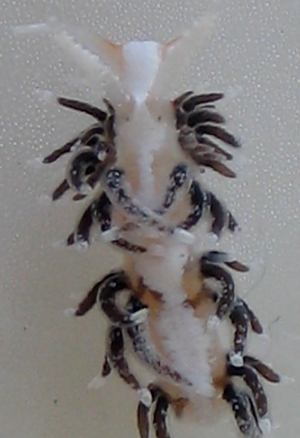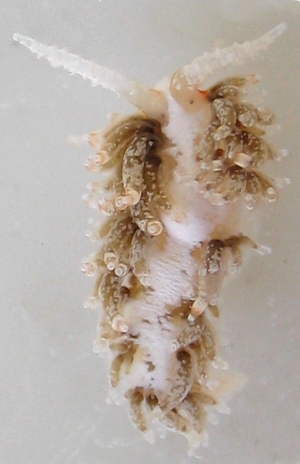
Learchis poica
Marcus & Marcus, 1960
Order: NUDIBRANCHIA
Suborder: AEOLIDINA
Family: Glaucidae
DISTRIBUTION
Caribbean, West Africa (Ghana)
PHOTO
The three photographed animals are all from Abaco, Bahamas, at a depth of about 1m:
Upper Right: 8mm. On Sargassum on shoreline rocks, Cooperstown. July 18, 1998.
Lower Left: 12mm. On hydroids on attached Sargassum at Pinder's Point. June 25, 1994.
lower Right: 14mm. On hydroids on attached Sargassum, Roberts' Boatyard. June 9, 1996. Photos: Colin Redfern.
The rhinophores are variously described as annulate, perfoliate and lamellate. In descriptions of living animals the rhinophores are consistently said to have an irregular arrangement of rings or annulations, some of which are irregular or incomplete. The species is somewhat variable in colour but usually contains the following elements. The animal is translucent clear with white patching on the head and behind the rhinophores. Sometimes the white pigmentation forms a broad continuous median band from the front of the head to the tip of the tail. There can also be an opaque white band of irregular shape and width down each side of the body below the cerata. There are often orange markings on the head, often consisting of an orange line from the base of the oral tentacles to the base of the rhinophores. There can also be an orange patch on each side of the head, sometimes called a 'cheek patch'. It can be replaced by an orange line from the base of the rhinophores to the foot, or from below the rhinophores forward to the front of the head below the oral tentacles. The cerata are tranlucent clear with a few scattered white patches and a subterminal white band. The digestive gland duct can range in colour from light to dark brown. See Learchis evelinae.
References:
• Edmunds, M. 1964. Eolid Mollusca from Jamaica, with descriptions of two new genera and three new species. Bulletin of Marine Science of the Gulf and Caribbean, 14(1): 1-32.
• Edmunds, M. (1968) Eolid Mollusca from Ghana with further details of west Atlantic species. Bulletin of Marine Science, 18(1): 203-219.
• Edmunds, M. & Just, H. (1983) Eolid nudibranchiate Mollusca from Barbados. Journal of Molluscan Studies, 49(3): 185-203.
• Marcus, Ev. & Er. Marcus. 1960. Opisthobranchs from American Atlantic warm waters. Bulletin of Marine Science of the Gulf and Caribbean, 10(2): 129-203.
• Redfern. C., 2001 Bahamian Seashells: a Thousand Species from Abaco, Bahamas.
• Thompson, T.E. (1977) Jamaican opisthobranch molluscs I. Journal of Molluscan Studies, 43(2): 93-139, pls.1-3.
• Thompson, T.E. (1980) Jamaican opisthobranch molluscs: II Journal of Molluscan Studies, 46(1): 74-99.


Rudman, W.B., 2002 (September 22) Learchis poica Marcus & Marcus, 1960. [In] Sea Slug Forum. Australian Museum, Sydney. Available from http://www.seaslugforum.net/find/learpoic
Related messages
Learchis poica colour forms
February 26, 2007
From: Alvin Alejandrino

Dear Dr. Rudman,
I wanted to share some of my Learchis poica pictures. They show three color forms of the species. I collected them all at one site from a plane wreckage just north of South Bimini Island in the Bahamas (N25d 42.008 min, W79d 15.162 min).
There were a total of 5 specimens. One had black cerata, another had whitish cerata, and the remaining three had brown cerata. During my observations, I kept them in the same petri dish. Sure enough the three color forms tried to mate. I kept them separate overnight, but it was too late because I woke up finding egg masses in the dishes.
My molecular analysis of their DNA is indicating that they are closely related to each other with small divergence in their sequences.
Locality: South Bimini Island, 2 meters, Bahamas, Caribbean, 21 March 2006, Plane wreckage on sandy bottom. Length: 6-15 mm. Photographer: Alvin Alejandrino.
Alvin Alejandrino
alejandrino75@yahoo.com


Thanks Alvin,
It would be nice to know what your research project is. This species certainly shows a lot of colour variability, but the black-brown-whitish ceratal colour variation is not a result of genetic differences but a rsult of the colour of the contents of the digestive gland duct in each ceras. In your photos the upper one with black cerata suggests it has fed on hydroids very recently while the brownish cerata in the lower left photo suggests the animal is at the end of its digestive cycle and only a bit of undigested food is left. The lower right photo which shows black just at the base of the cerata probbaly indicates that the animal has recently started feeding and the cerata are beginning to fill up with food.
If you are looking for genetic colour variations then you should look for differences in the orange-red markings on the head, the orange rings on the cerata, the amount of opaque white patching on the ceratal wall, and the nature of the white band down the dorsal midline of the body
Best wishes,
Bill Rudman
Learchis poica from Southeast Florida
February 13, 2004
From: Linda Ianniello

Dr. Bill,
I believe this is a Learchis poica.
Location: Lake Worth Lagoon, Florida, Southeast USA
Depth: 15 feet
Date: February 2, 2004
Size: About 1/2 inch
Regards,
Linda I.
lindai@us.ibm.com
Ianniello, L., 2004 (Feb 13) Learchis poica from Southeast Florida. [Message in] Sea Slug Forum. Australian Museum, Sydney. Available from http://www.seaslugforum.net/find/12128Thanks Linda,
It's a bit hard to see much of the colour pattern from this angle but I am pretty sure you are right. The relatively long rhinophores, in comparison with the length of the oral tentacles, agree with Learchis poica.
Best wishes
Bill Rudman
Learchis poica from the Bahamas
September 24, 2002
From: Colin Redfern

Dear Bill,
In response to your request for photos of Learchis poica, here are three from Abaco, Bahamas. Marcus & Marcus (1960) described the rhinophores as perfoliate, but in Abaco they are mostly annulate. However, the annulations are often irregular or incomplete, as observed by Edmunds (1964) on animals from Jamaica.
The three photographed animals are all from Abaco, Bahamas, at a depth of about 1m:
Upper Right: 8mm. On Sargassum on shoreline rocks, Cooperstown. July 18, 1998.
Lower Left: 12mm. On hydroids on attached Sargassum at Pinder's Point. June 25, 1994.
lower Right: 14mm. On hydroids on attached Sargassum, Roberts' Boatyard. June 9, 1996.
References:
• Edmunds, M. 1964. Eolid Mollusca from Jamaica, with descriptions of two new genera and three new species. Bulletin of Marine Science of the Gulf and Caribbean, 14(1): 1-32.
• Marcus, Ev. & Er. Marcus. 1960. Opisthobranchs from American Atlantic warm waters. Bulletin of Marine Science of the Gulf and Caribbean, 10(2): 129-203.
• Redfern. C., 2001 Bahamian Seashells: a Thousand Species from Abaco, Bahamas.
Best wishes,
Colin
Bahamianseashells@att.net


Thanks Colin,
I am afraid words like 'perfoliate' and 'annulate' are not used very consistently in the literature. Also Marcus & Marcus were describing the anatomy of preserved specimens, and from their drawings the rhinophores are greatly contracted. The 'perfoliations' could easily just be wrinkles caused by the contraction. I also see the only information they give us of the living colour is 'the living slugs had paler or darker reddish brown diverticula of the digestive gland shining through the epidermis of the cerata, whose tips were white'. Fortunately Edmunds, in a number of publications, and Thompson, have given us quite a full account of this species and its variations.
Best wishes,
Bill Rudman
